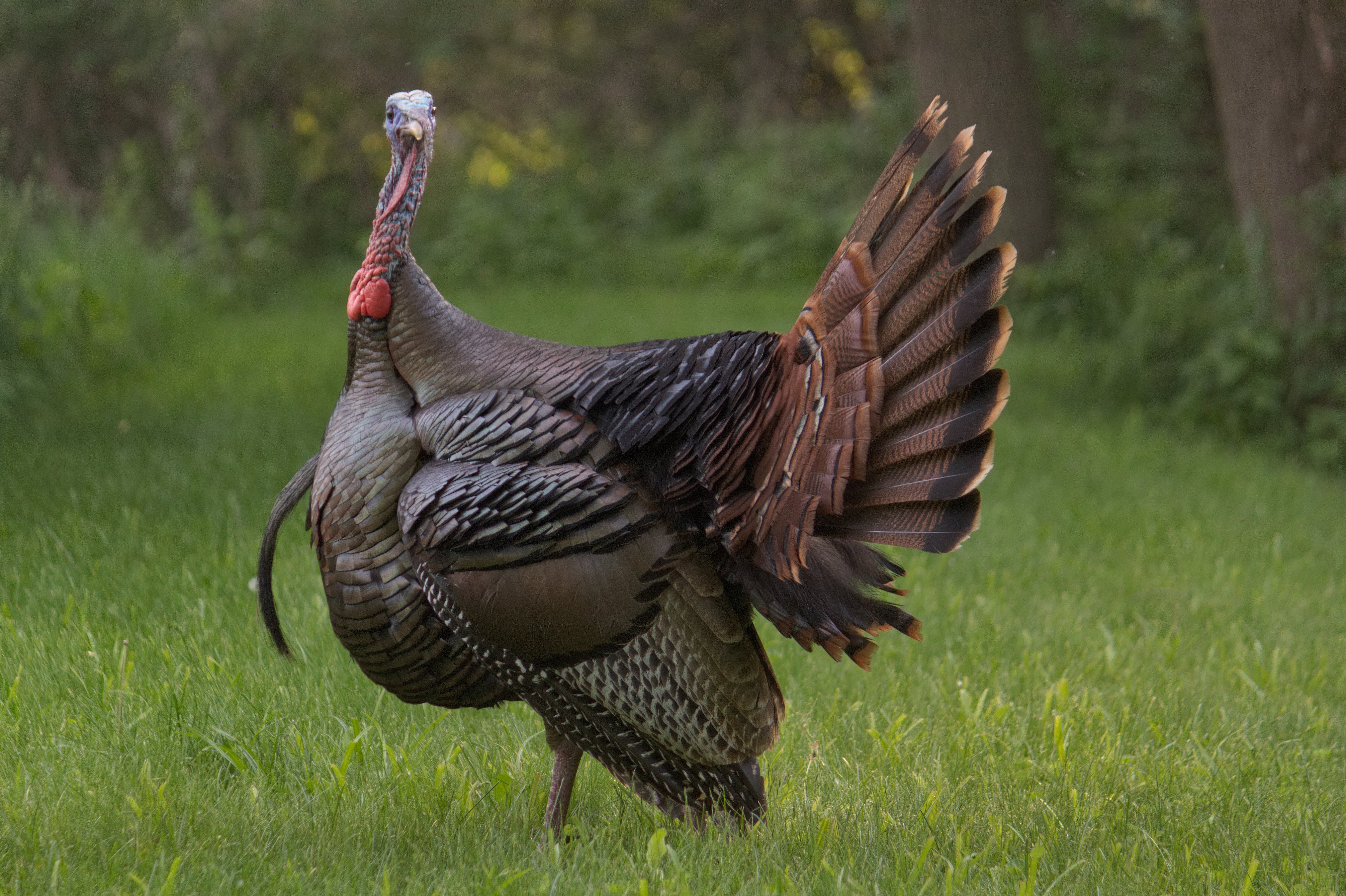Here, instead of shilling my own stuff let’s shill something somebody else made for a change.
In my last actual column I mentioned in passing, and at the tail end of a very long wall of text, the possibility of a better value for a balisong trainer in today’s market than even a Chinese knockoff. While we’re at it, we can simultaneously answer a question nobody asked, namely which trainer knife do I actually use?

The answer is this one.
This is the Kershaw Balanza. It’s brought to you by the color grey. I think this might be the most monochromatic set of photos I’ve ever taken that didn’t involve black and white film. Not that you’d know by looking.
Note that I didn’t say trainer version – That’s because for some twisted reason, no live blade version of this knife seems to exist. Kershaw do make a couple of other balisongs that come in both live and trainer variants, just… not this one. This comes as a trainer only. It’s just one of those things, I guess.
The Balanza has list price of $60 with a real world street price of about $42, which means it’s slightly cheaper at present than the knockoff I reviewed last week. So for once in history maybe it’s a better idea to get this instead of the Ching Chow Special.
Even notwithstanding that, it’s got a couple of highly attractive features up is sleeve which I think make it a genuinely good value for what it is. And in the bargain you can also buy it from an actual company you’ve heard of and might even like, rather than some anonymous shitheads.
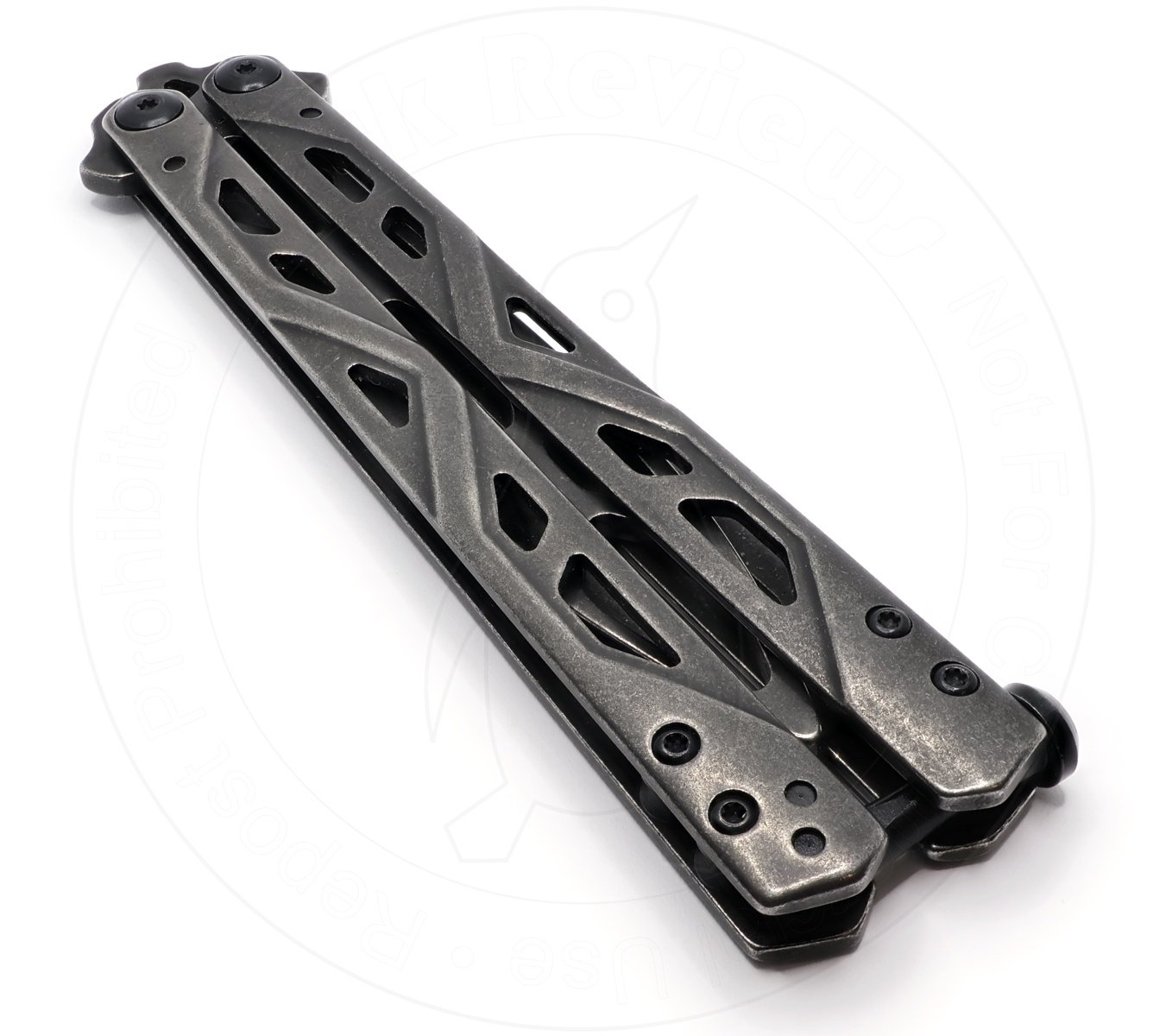
Yes, I am well aware of the heat I am about to bring down on myself from the various balisong nerds all over the internet by defending this product. It seems that the Balanza is universally reviled. Everyone hates this knife, apparently. Complaints abound about it being “too heavy,” or “handle biased,” or allegedly “breaking all the time.”
And yet, I like the Balanza. And for once not just for deliberately contrarian hipster purposes, either.
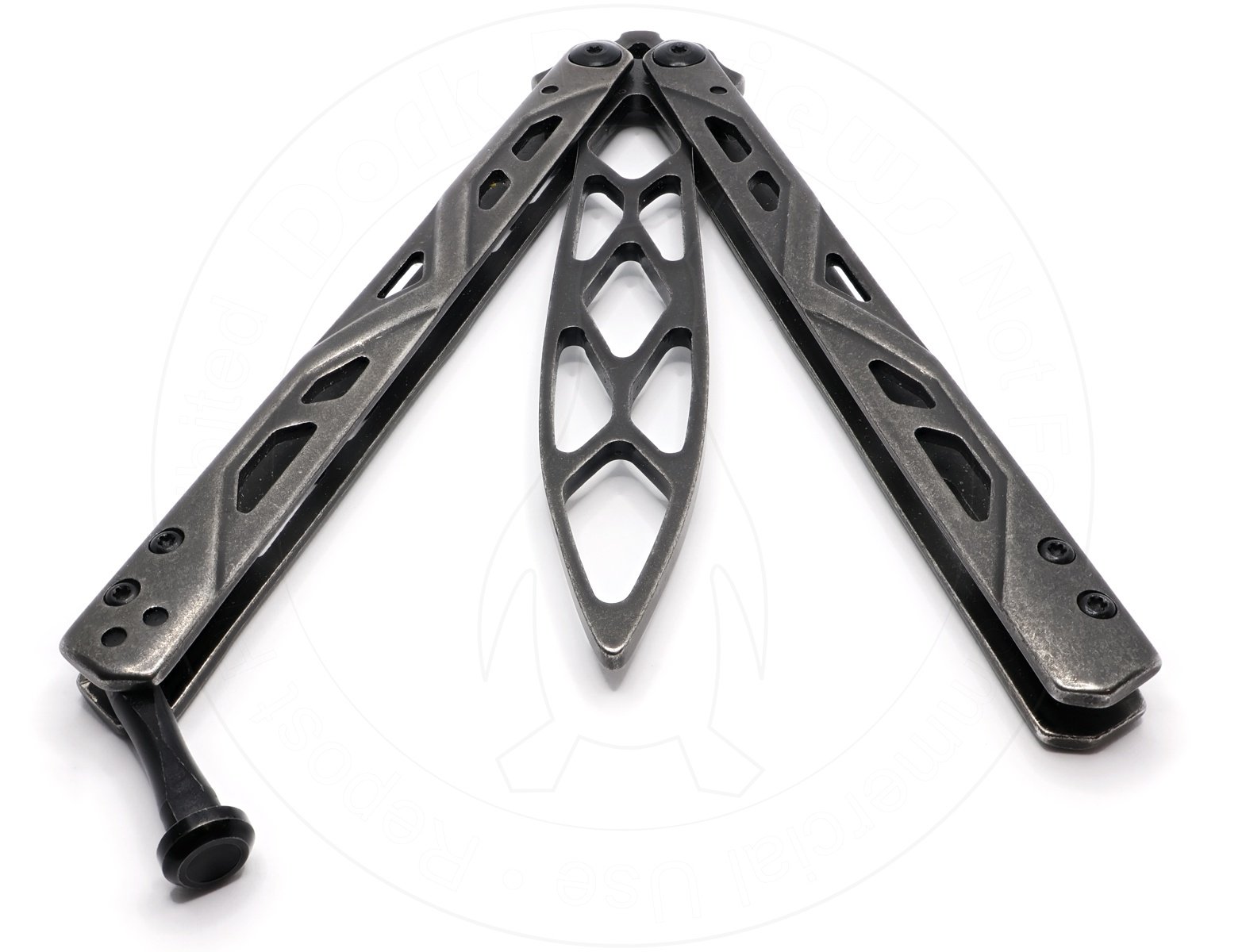
And it’s undeniable that the Balanza is ostensibly constructed in much the same way as Kershaw’s other balisongs, one example of which I own: That’d be the Moonsault, which I tore a new asshole in one of my very first writeups on here.
So what gives? With its ignominious reputation and our inauspicious start to things, can the Balanza ultimately be redeemed?
Sizing Up
It is inevitable when talking about this sort of thing that the comparison between this and a bunch of other knives will come up. Kershaw’s other knives, sure, and my Moonsault in particular. But to use a technical term, there are a shitload of other popular balisong trainer knives out there in the world, all competing to be your entry point into the world’s most sedentary extreme sport.
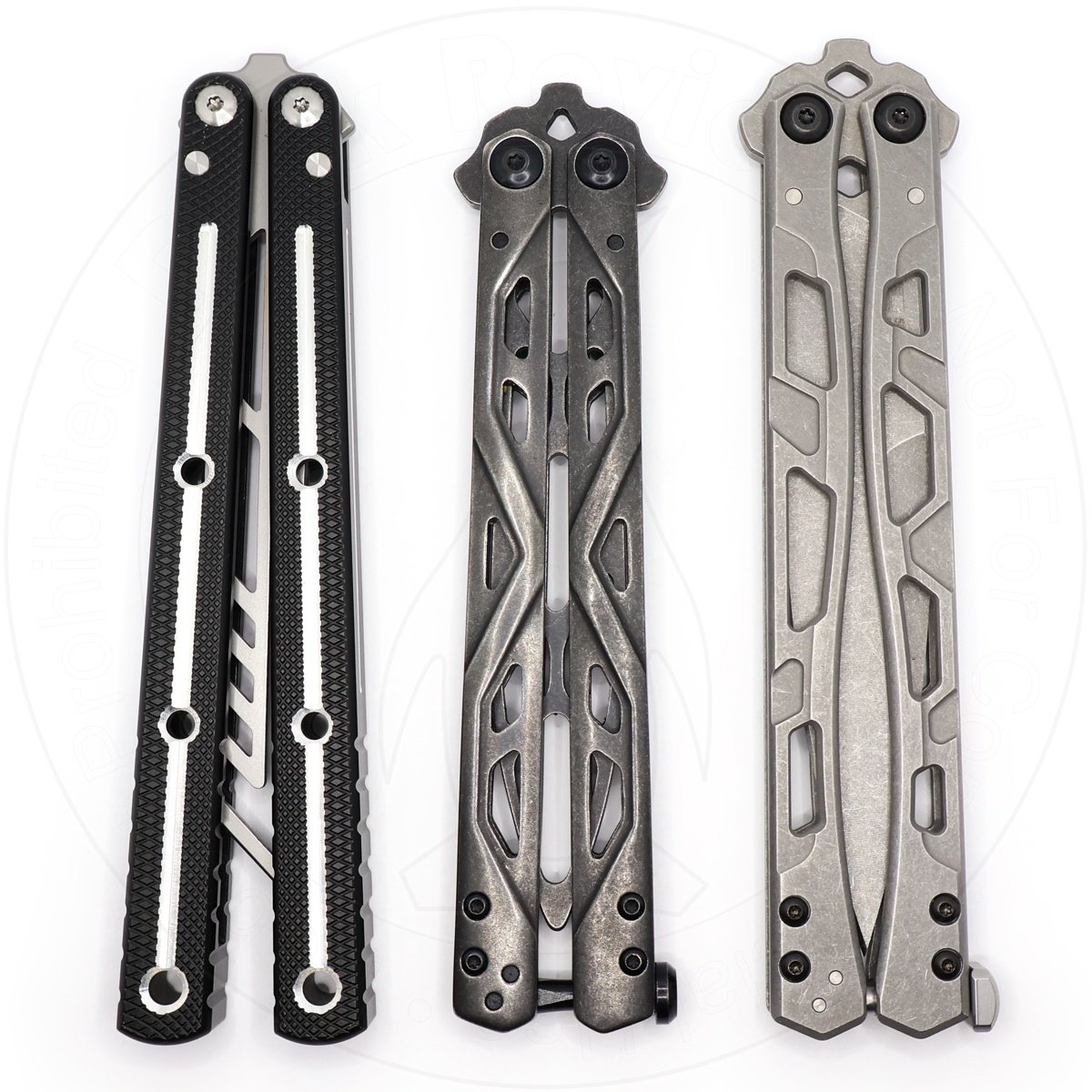
One of my knocks against the Moonsault is that it’s too damn large. The Balanza is noticeably smaller, and much more in line with a “traditionally” sized balisong. It is neither comically huge nor uselessly tiny, and therefore doesn’t achieve anything interesting in that department at all. I know this is heresy, coming from me.
When closed the Balaza is 5-1/2" long, and it’s 9-3/8" or so opened with, once again, a groovy skeletonized blade that’s completely symmetrical (almost) and also obviously not sharp. That puts it at “only” 7/8" shorter than the Moonsault, but that fractional reduction in bigness is actually very important for its usability.
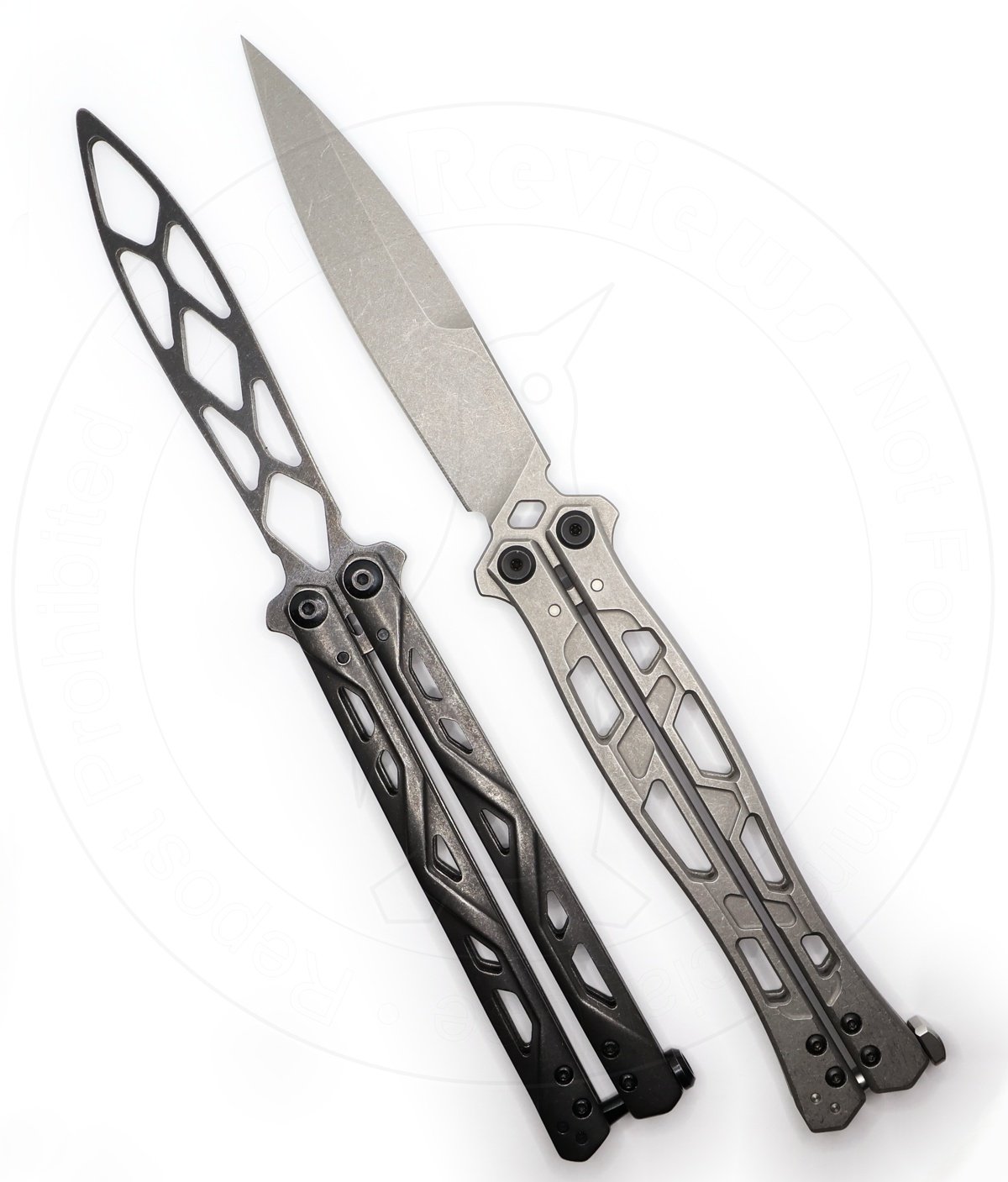
It’s actually noticeably slightly shorter than the Krake Raken as well, initially to the tune of a very deceptive 1/8" overall when closed. Its blade is almost the same length but the handles are quite a bit shorter, about half an inch, which also has the net effect of moving the pivots back by roughly 3/8".
Similar to most other balisongs, the handles are tapered. At their widest by the tail they’re 0.486" across and up at the pivots they’re just about 0.414". At rest the knife is noticeably flared in both the open and closed positions, about 15/16" in total at the narrow end and 1-1/4" at the tail, not including the latch. The handles are 0.406" thick, and achieve a very pleasing feel by being subtly rounded over on all the corners, slots, and edges. This means the profile is somewhat flat, but not excessively so. The assembled handles are slightly wider than they are tall (or shorter than they are wide, if you prefer). The entire knife has a satiny stonewashed surface over a finish that looks, at least, as if it’s been blued. Kershaw calls this “blackwash,” and it’s a gunmetal grey that’s not only attractive, albeit a bit boring, but so far also appears to actually hold up pretty well. Since as usual mine has left several craters in the Earth as a result of fucking around with and subsequently fumbling it.
All of this is in stark contrast to the aforementioned Moonsault, which feels slightly weird because it lacks the taper (although the inner edges of its handles are wavy instead), is more angular and less roudned, and also has a rougher, snaggier surface that seems to show scuffs rather than hiding them.
There’s a lot to recommend about the Balanza’s design, or at least it has a couple of features that I like which really ought to amount to the same thing. The biggest headline, of course, it that it’s a ball bearing pivot knife. As such it’s guaranteed to have consistently effortless and low-drag action, and head and shoulders above its similarly priced competition which is usually bound to have bushings or worse, just plain washer pivots.
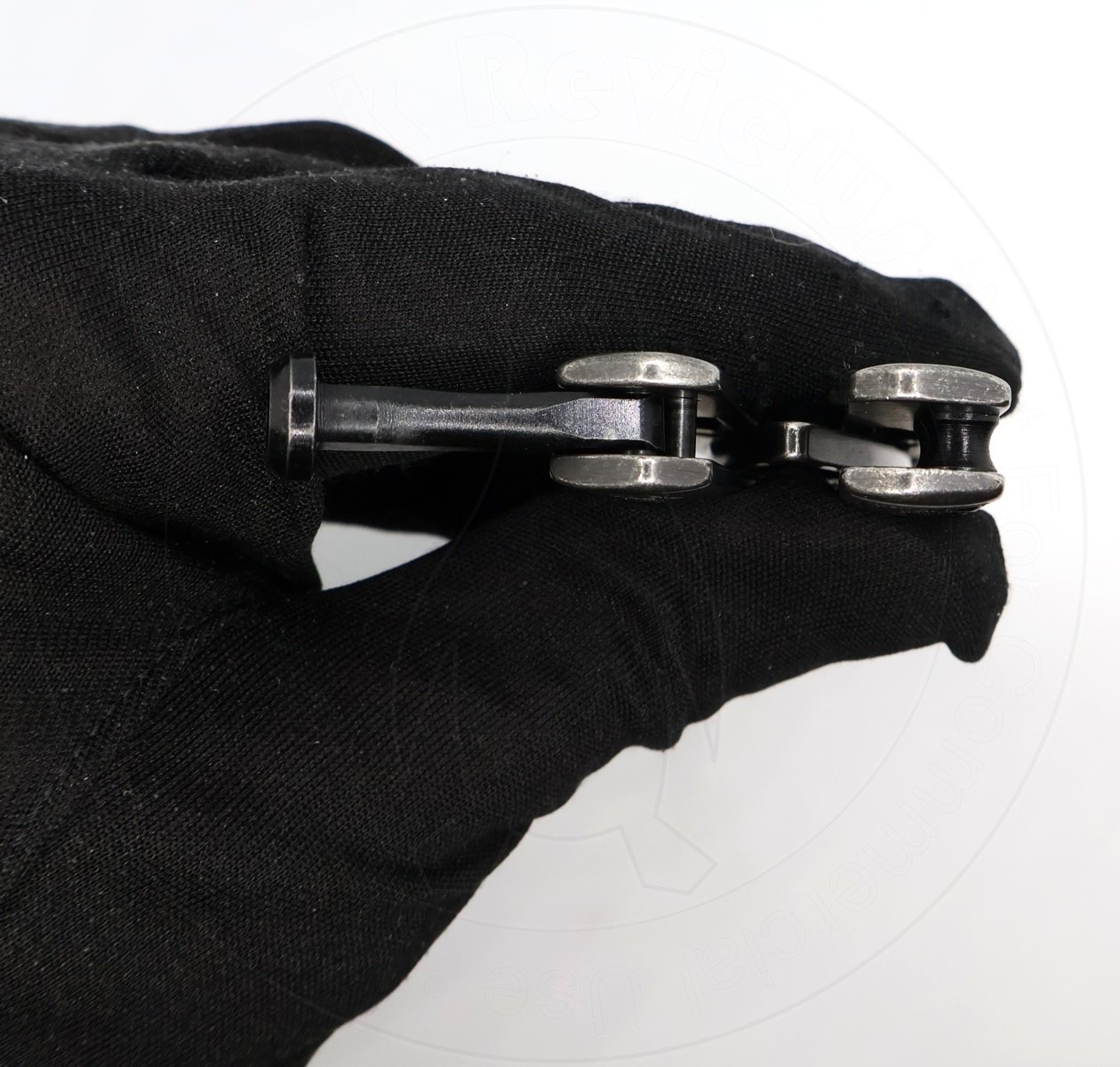
Lots of trainer knives promise “no play, no tap” in their descriptions. The Balanza, meanwhile, actually achieves it. The pivots are authoritatively solid with no wiggle. There’s only a small amount of flex in the handles themselves.
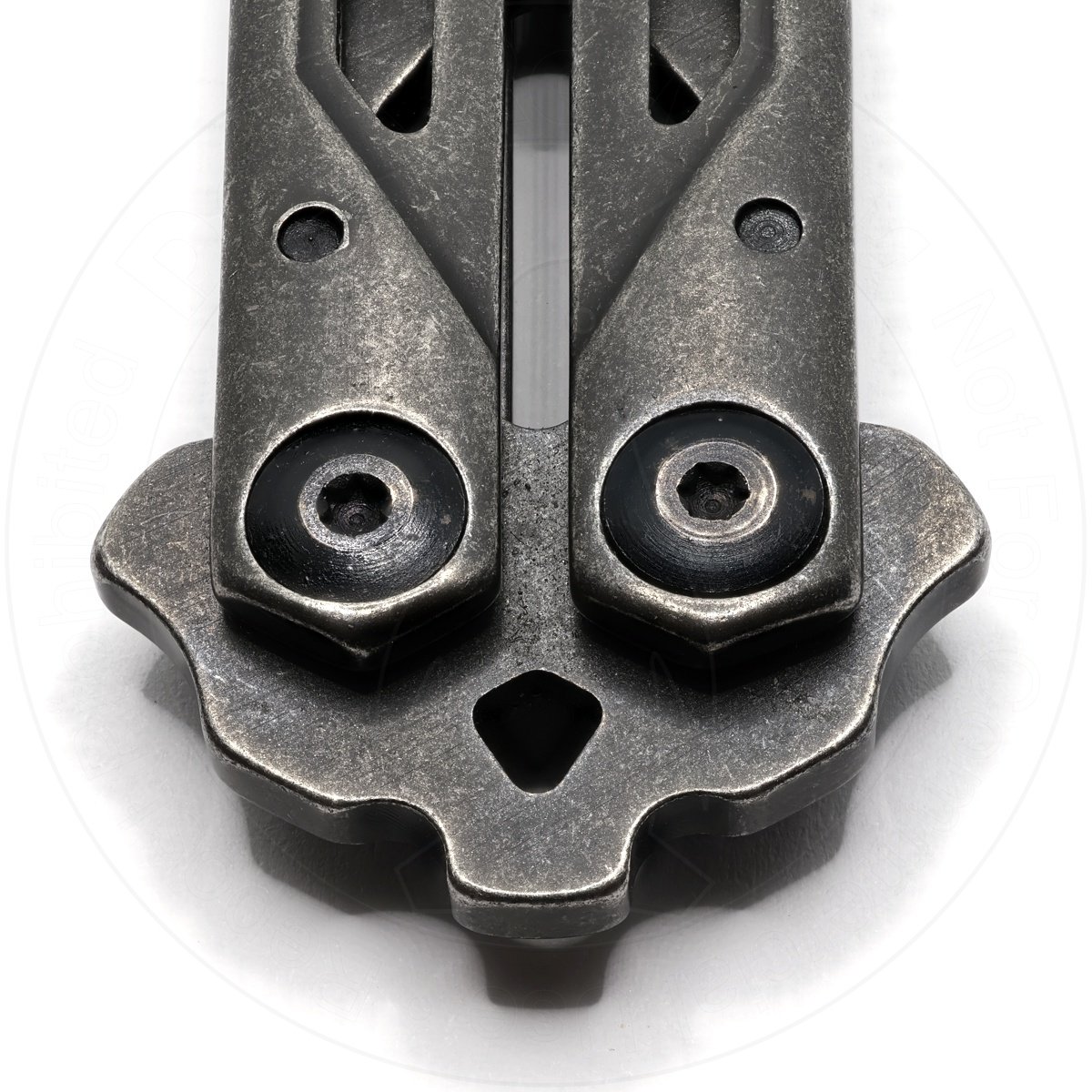
It has a kickerless mechanism with Zen rebound pins in the handles as well, rather than traditional kicker pins pressed through the blade.
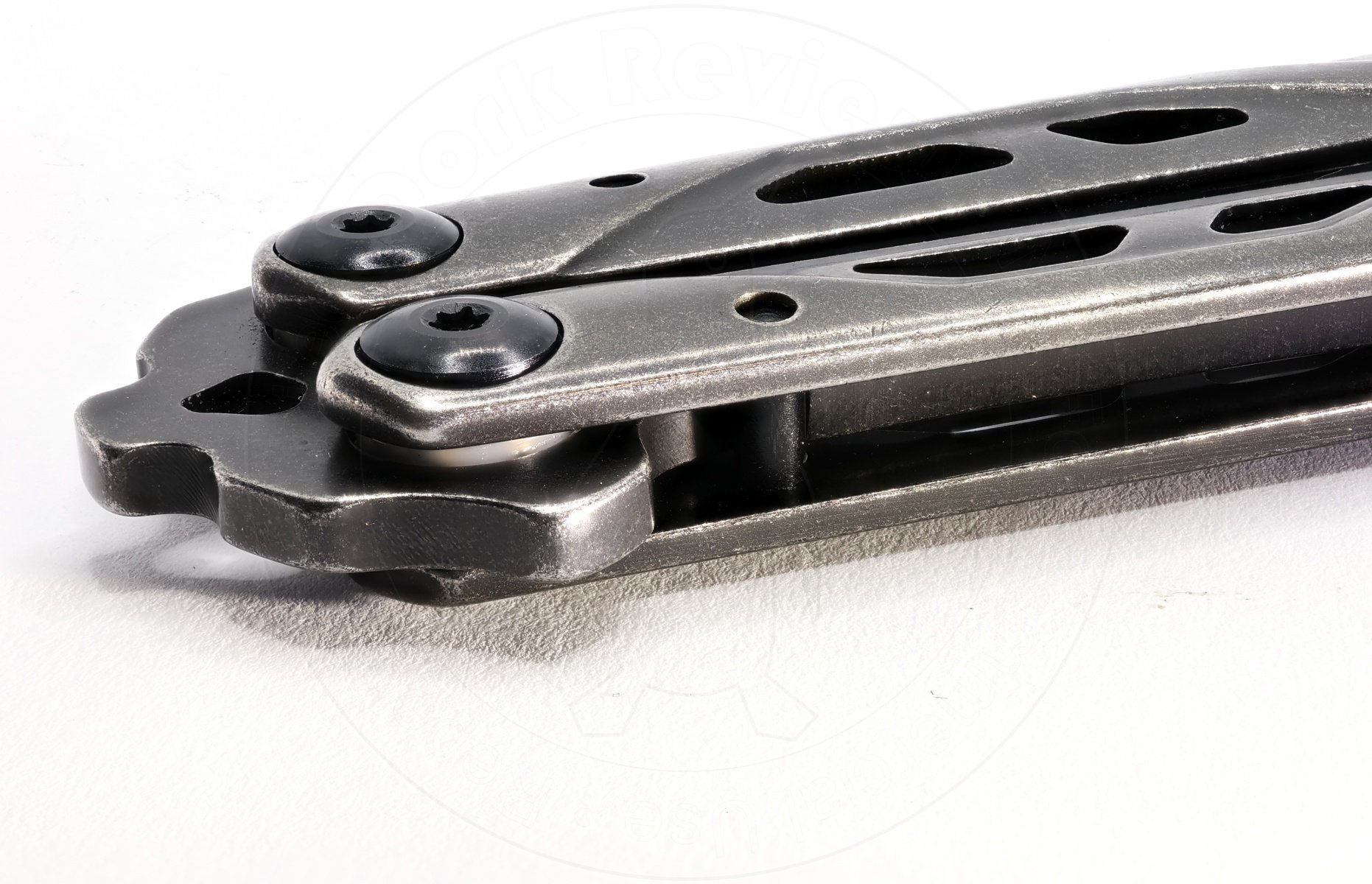
One of these is shown here with the aid of my little Lumintop Tool AA 2.0 flashlight, because otherwise it’s awfully dark in there between the handle scales. And while we’re at it, just check out the texture on the sheet of paper I use as a background.
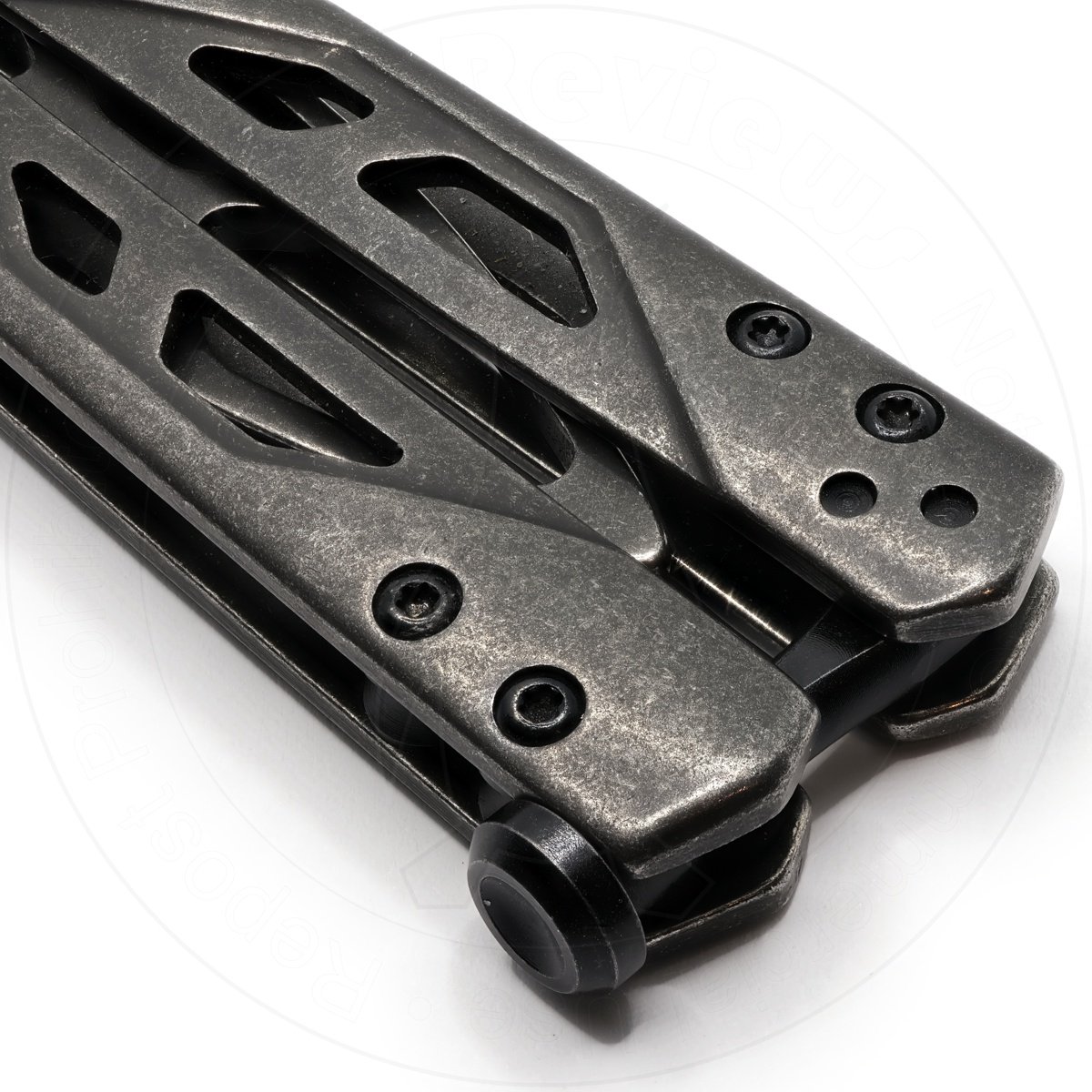
While its latch isn’t zooty and spring loaded, at least the Balanza has one – unlike a lot of trainer knives – which not only keeps it from flapping open in your pocket but also opens up the possibility of using it to practice tricks that rely on the presence of a latch. It’s also good practice if you plan to use it as a stand in for a live bladed equivalent that’s got a latch, which if you’d like to not irritate the shit out of yourself you might want your actual daily carry knife to have. (I certainly do, anyway.) It’s nicely tensioned on my example and easy to kick loose with your pinky without any undue effort, although it rattles around a bit on its pin.
There is no clip, but this is not unexpected given that none of Kershaw’s balisong offerings have one, whether they’re trainers or not.
Breaking Down
The Krake Raken knockoff we looked at previously is all aluminum, and is one of those flash high speed modern jobbies that weighs very little and is very springy. Which if we’re honest, maybe makes it a little too lively.
The Balanza, meanwhile, isn’t. It’s constructed entirely of steel – Handles, pins, blade, all of it. That means its heavier at 129.8 grams or 4.58 ounces. (Meanwhile, however, that is around 3/4 the weight of a Moonsault, which is a knife that I think is just about on the far side of being impractically heavy.)
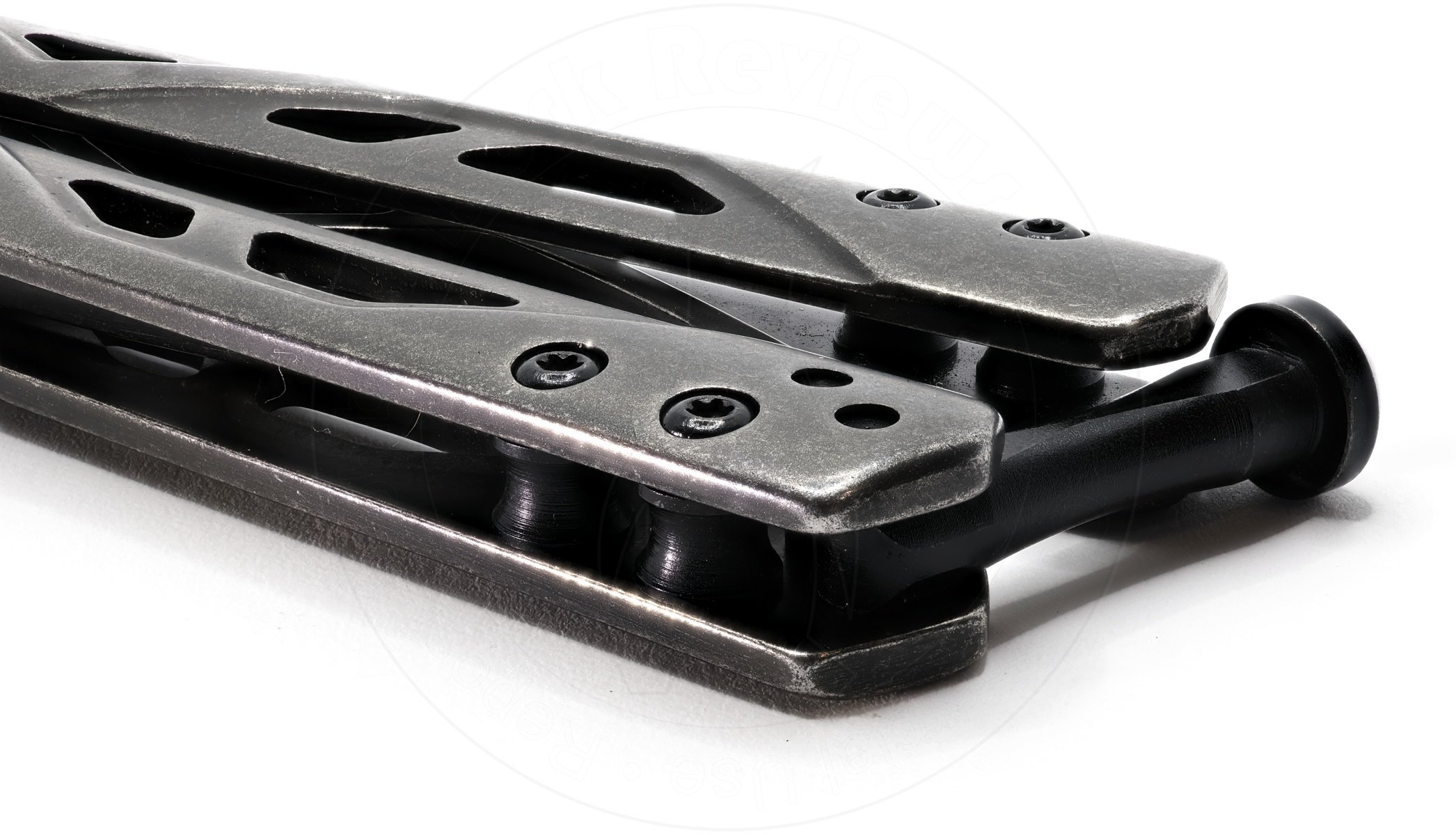
It’s a sandwich design, with each handle comprised of two steel slabs separated by some nice diabolo shaped spacers.
It’s also a nice palate cleanser after our last disassembly debacle with that Krake Raken clone. The Balanza is gloriously easy to take apart.
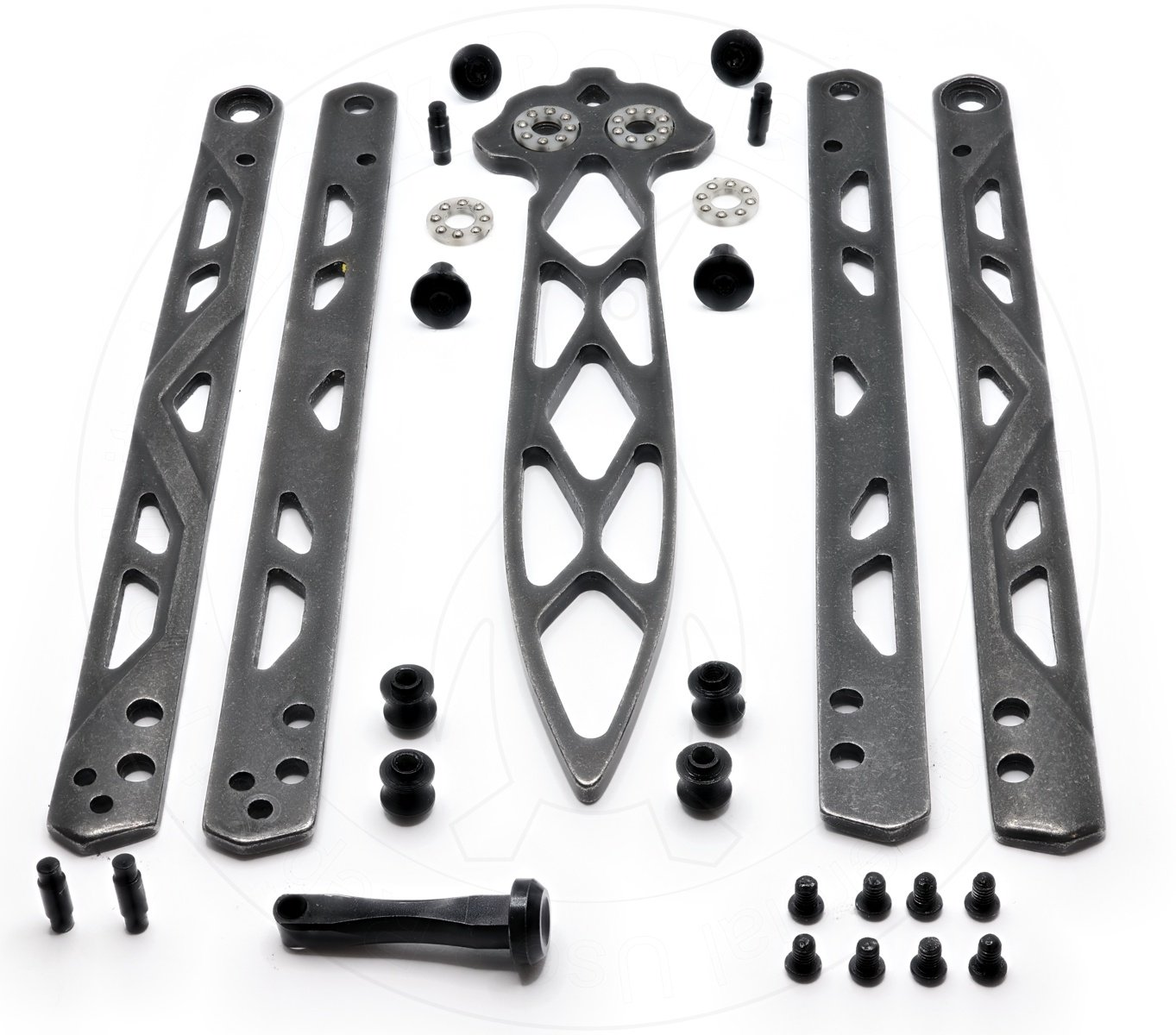
It just comes apart with regular Torx screws and without even requiring a heroic amount of effort. No blowtorch, pry bar, or tactical thermonuclear warhead is required. The screws are factory threadlockered, but not excessively so. The body screws are all T6 Torx and the pivot screws are T8. Just watch for which side of the pivots house the male versus the female screws…
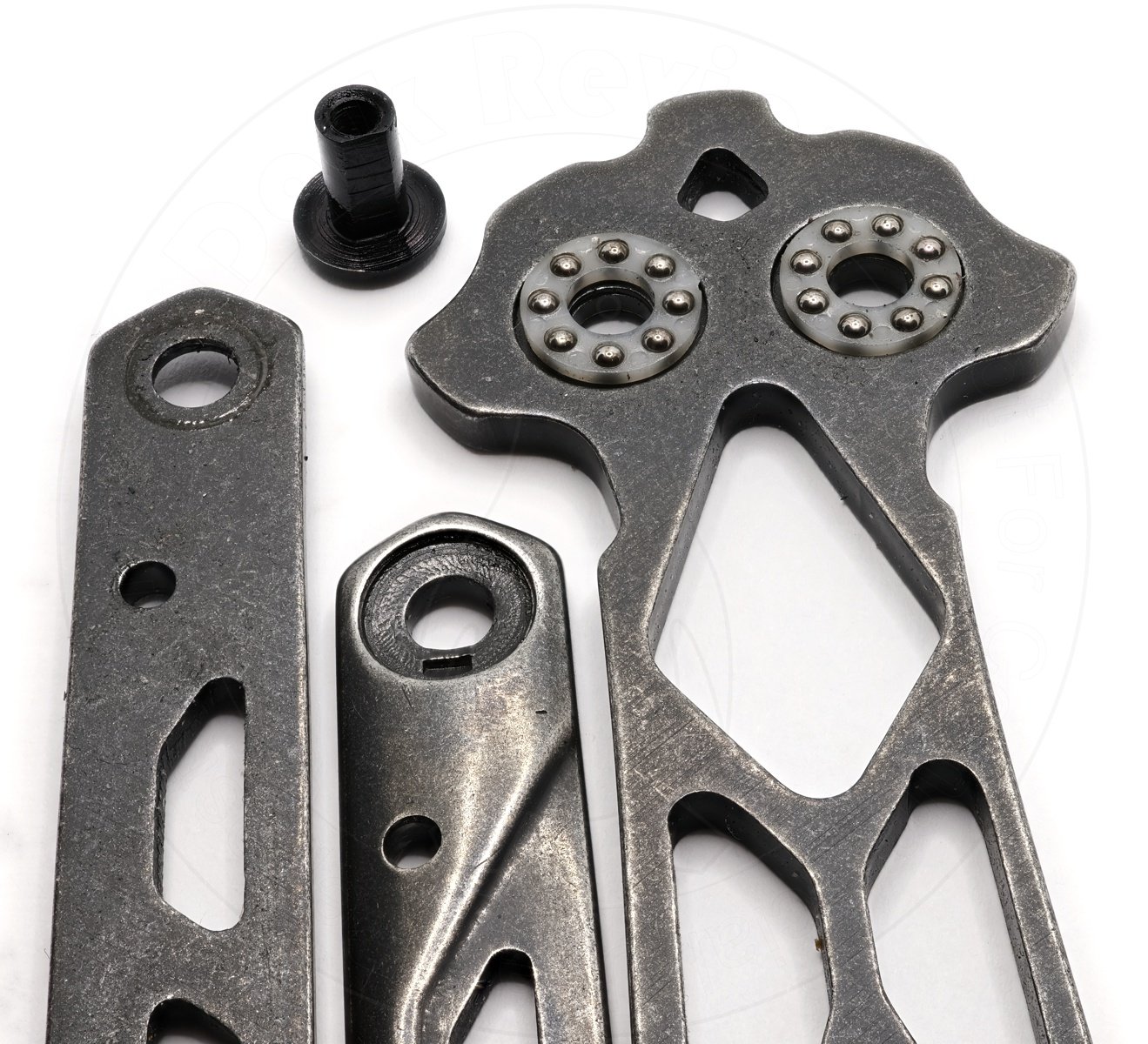
…Because the screws do indeed have anti-rotation flats on them and the female sides can’t be unscrewed. This is unlike the Moonsault, which has plain round screws.
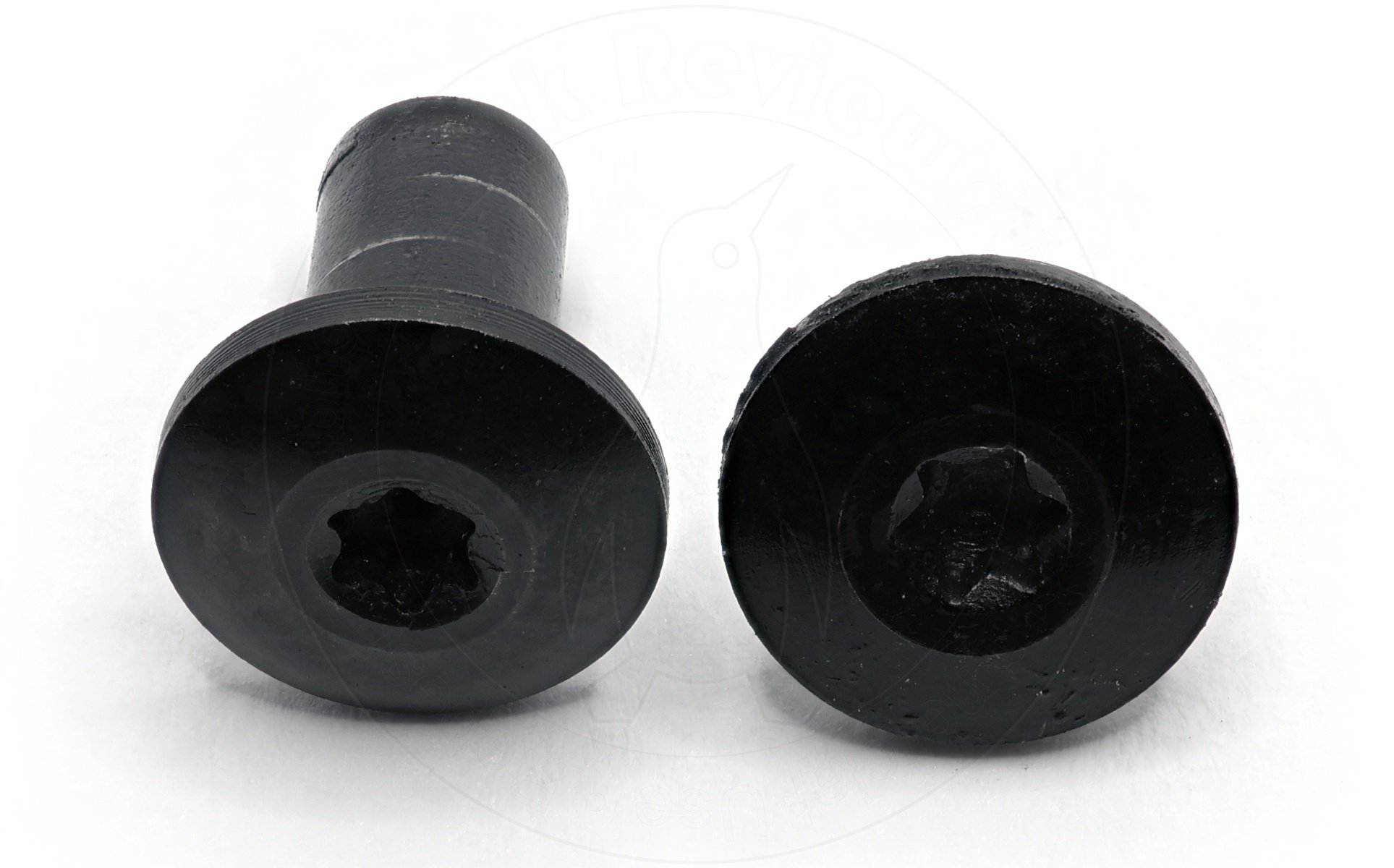
It’s subtle, but the heads are slightly different on each side. The male ones, i.e. the ones you can actually undo, are a tiny bit flatter. If you know this in advance it can help you identify them. If you don’t, well. Flip a coin.
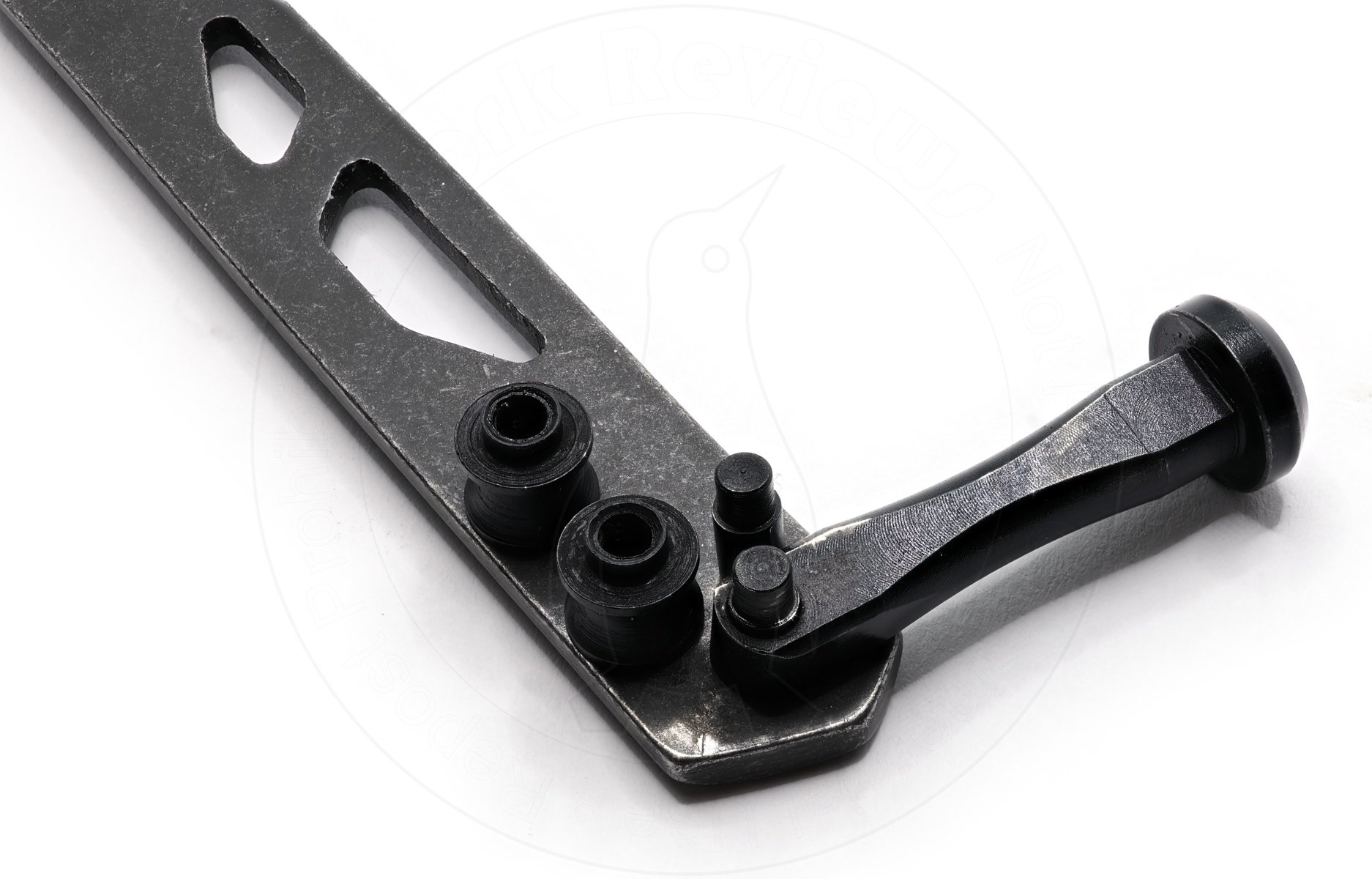
The Balanza is extremely simply constructed but it has it where it counts. The kicker pins and the latch pivot pin plus its endstop are shouldered and just drop into holes drilled in the handle slabs. All of the spacer screws and pins are the same as each other, so it’s impossible to mix them up.
And the latch does indeed have a built in endstop in the form of an extra pin to prevent it from contacting the blade. It’s stopped in its travel in the other direction by bumping up against one of the handle spacers. This system is simple, but it’s nice to see that Kershaw actually put some thought into it… unlike a lot of knife makers.
Of course, the ball bearing pivots are what we really want to see. Kershaw is very proud of these, to the extent that they’re one of the few manufacturers who bother to even mention when one of their knives has got 'em. In fact, they never seem to shut up about it so they’re probably making up for all the other manufacturers who don’t.
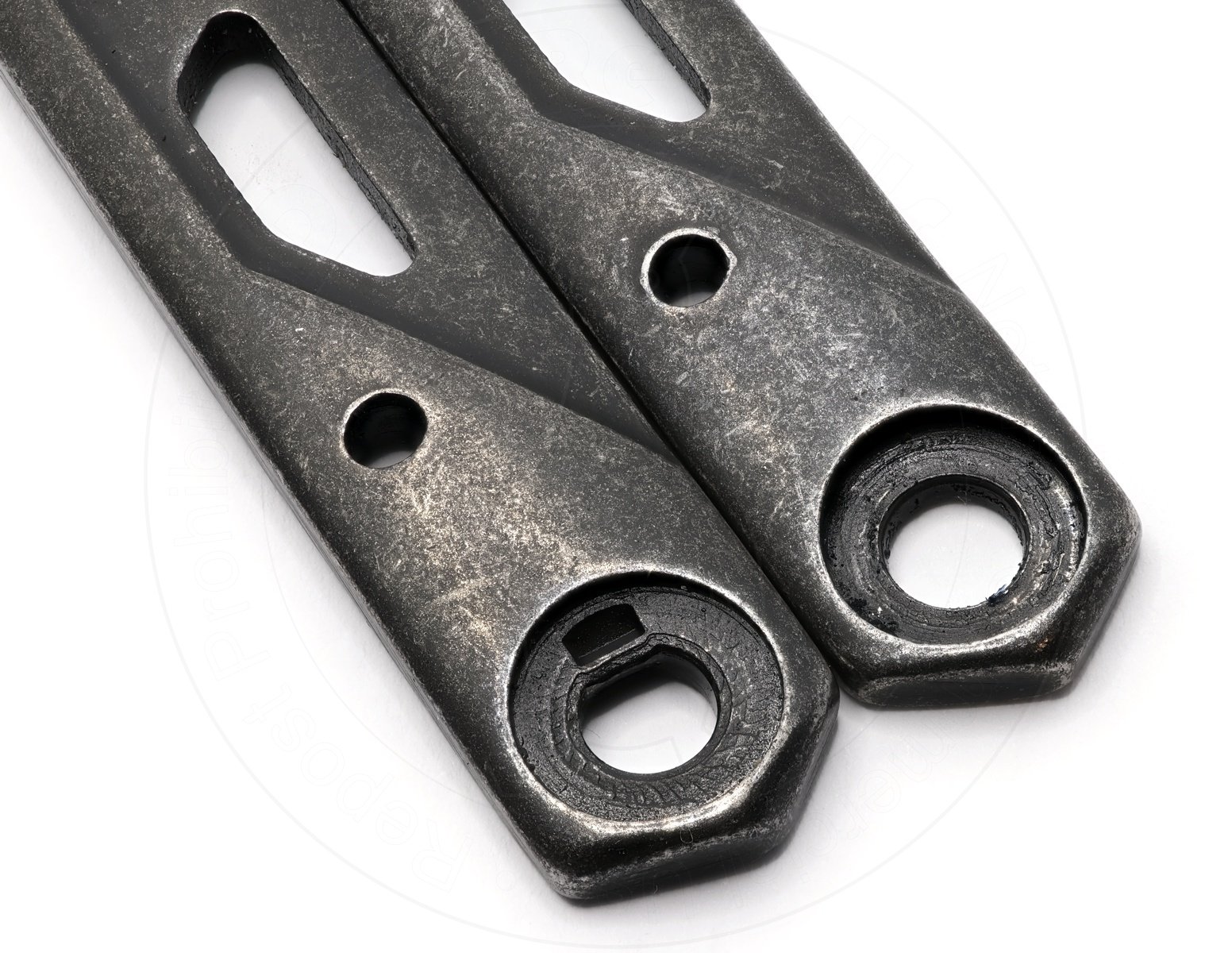
Note also the subtle difference between the pivot screw holes in the handle slabs. There’s a matching D shaped cutout for the anti-rotation flat on the pivot screws only on one of them, but it’s also marked with an extra notch to indicate this. The pivot screws can only be put in one way.

The hardware lineup. For a budget toy, the Balanza has a pretty long bill of materials. Eight body screws, four machined spacers, four shouldered pins, the pivots, and four sets of nylon caged ball bearing assemblies. The bearings are steel, not ceramic. Whadaya want for $42?
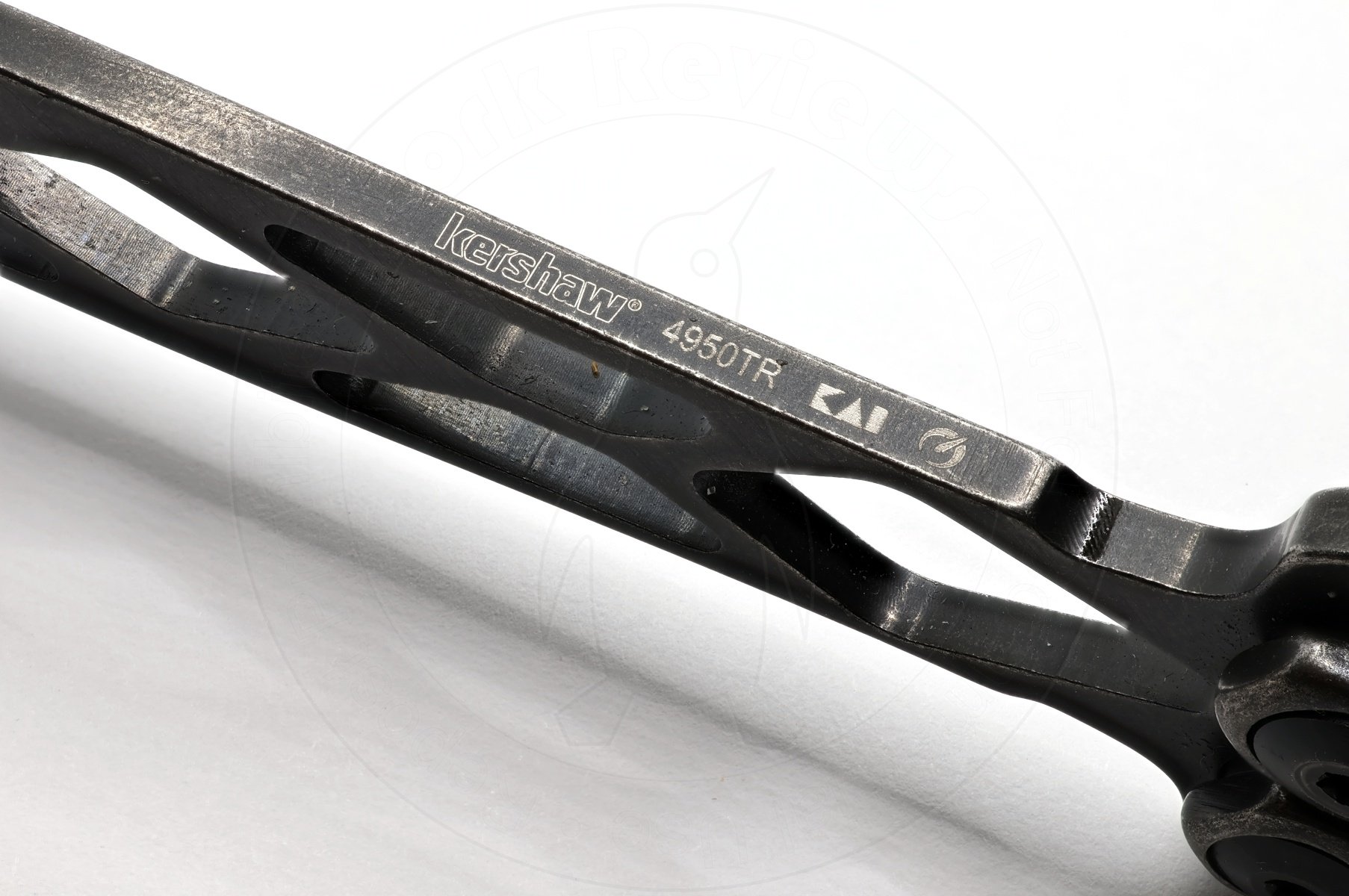
All the markings are hidden here on the edge of the blade. It’s up to you to decide if this edge is the “safe” or the “bite” side, but it’s the side that faces the latch handle from the factory so I’m in the latter camp.
Also note all the gumpf and pocket crud stuck to the inside of the cutouts, there. Woof. I should have cleaned this off better prior to photography, but I guess this is what I get for this being my actual working… er, not-knife. It lives in my pocket most of the time.
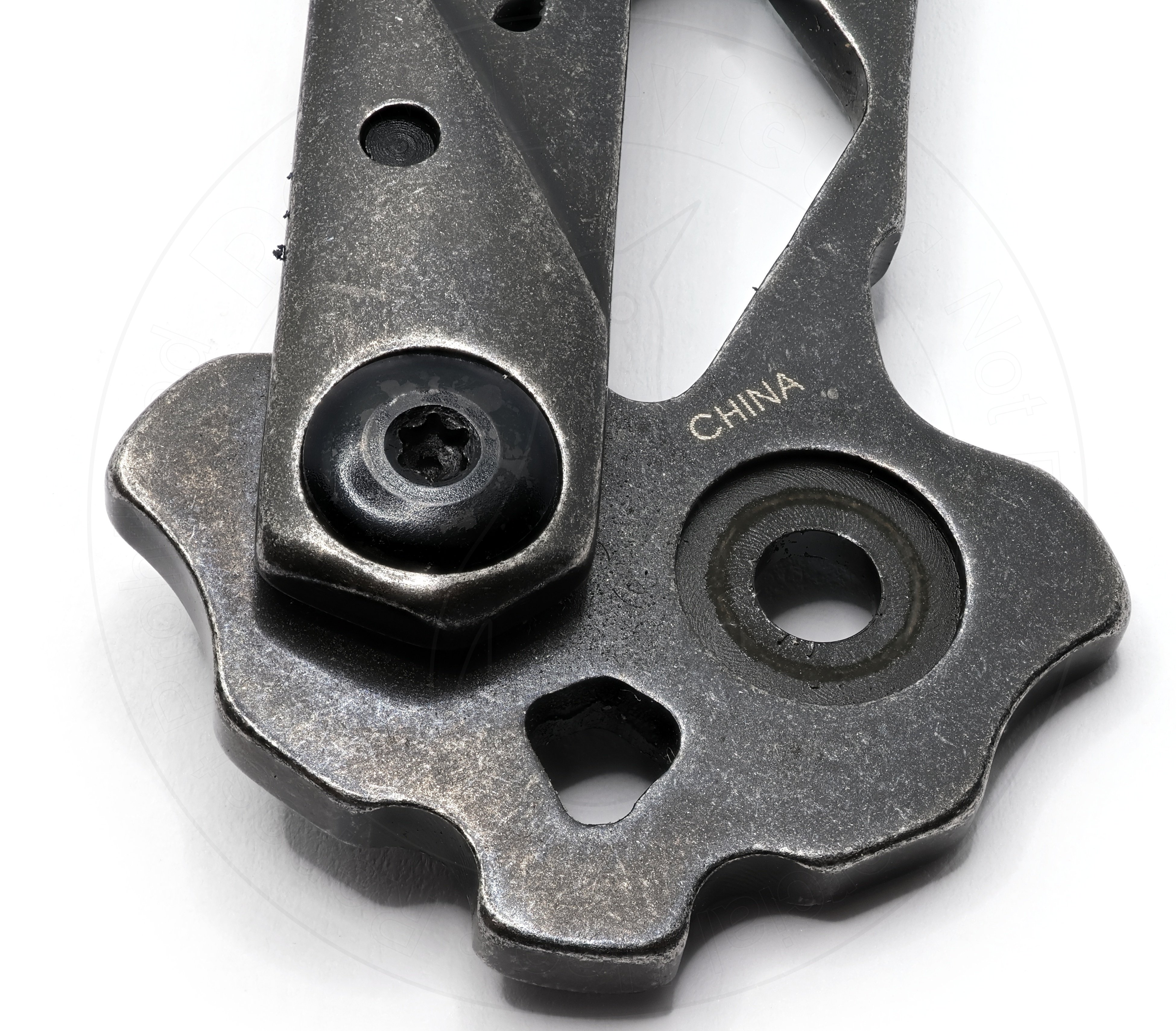
Hidden like the proverbial rake in the grass is the Balanza’s country of origin, laser-etched near the pivots via this near microscropic marking. Despite how I took this picture it’s still visible when the knife is assembled, but you have to know where to look.
It’s a little disappointing to see that this is one of Kershaw’s imported models. I figure it’d be an even better and much more fitting Fuck You to the clone manufacturers if this were made in the US, but it isn’t. The rest of Kershaw’s balisong lineup is US made if that matters to you, though: Both the Lucha and the Moonsault, in both their trainer and live bladed guises. So search me why this one isn’t, although the others (even the trainer versions) are all north of $200. That’s probably got something to do with it.
Alas, at the Balanza’s price point a US manufacturing origin is probably unrealistic. Oh well.
Flipping Around
If you believe the internet, a lot of people sure hate the Balanza. I’ll be damned if I know why.
I mean, I can guess why – It’s a heavy, stolid, unassuming looking, and dare I say highly conservatively designed balisong whereas the current fashion is zany brightly colored lightweight aluminum or titanium thingamabobs apparently all designed mostly to look good in a TikTok.
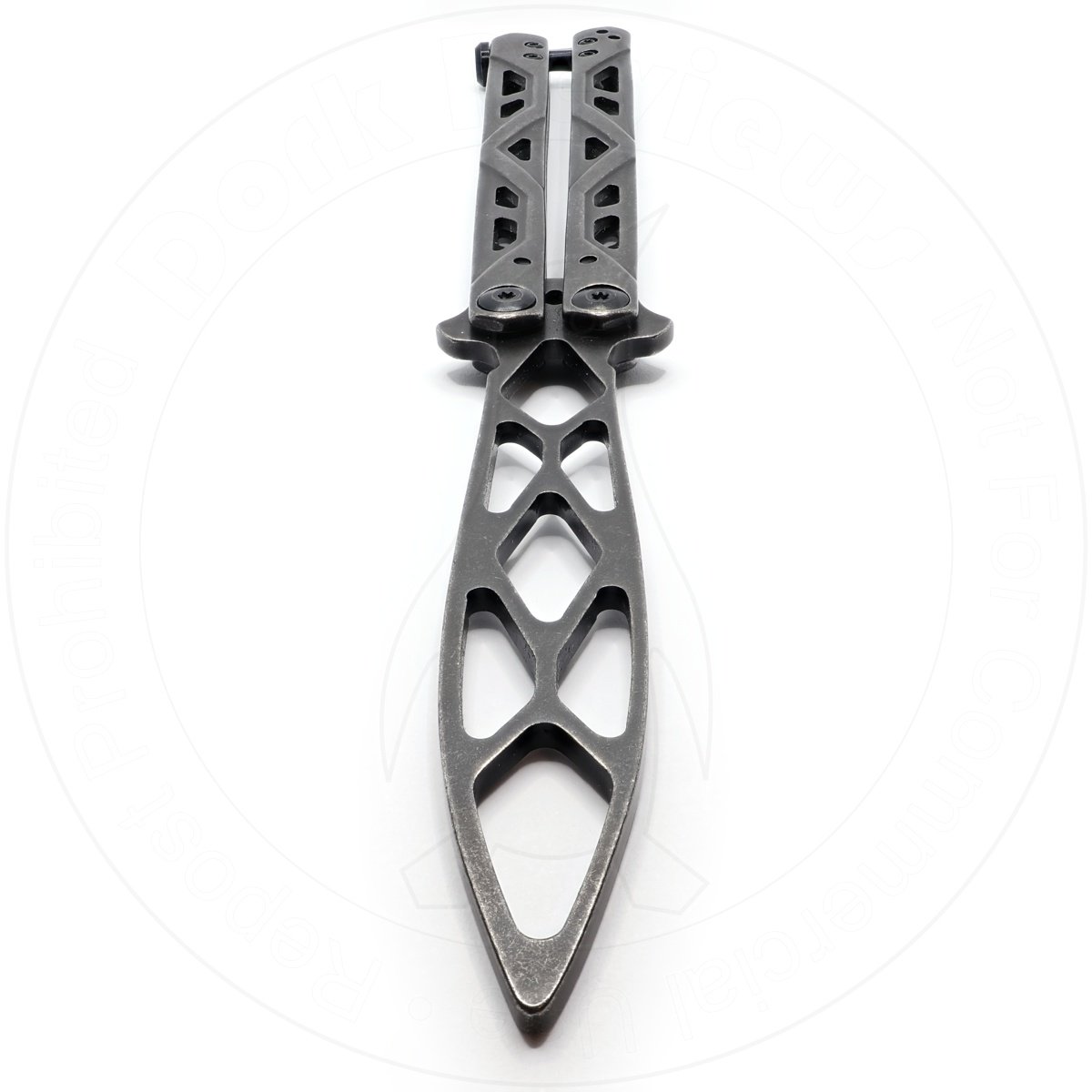
The Balanza is none of those things. But it makes up for it by being extremely controllable, with a consistent center of gravity and a predictable rebound feel. On our last outing I complained about the aluminum Krake Raken clone bouncing off of its rebound pins like it was on a goddamned trampoline. The Balanza doesn’t do this. When it hits its endstop, it stops. If you want it to bounce off, you have to make it bounce off. You’ve got wrists, don’t you? You’re in control, all the time.
This sort of thing is all highly subjective, of course. People like what they like and get used to what they’ve got. When your hobby is largely reliant on muscle memory, switching to anything that behaves differently is sure to honk you off at first, especially if any bystanders watching happen to mistake lack of familiarity for a lack of skill.
I get a lot of noise about the Balanza being “handle biased.” This is a pretty rich sauce, considering “Balanza” literally means “balance” in Spanish.
Well, I’ve got news for you, chief. All balisongs are handle biased, and the very few that aren’t wind up being nigh uncontrollable.
“Nuh-uh,” comes the chorus from the comments. “My favorite knife isn’t!”
Yes it is. But don’t just take my word for it.
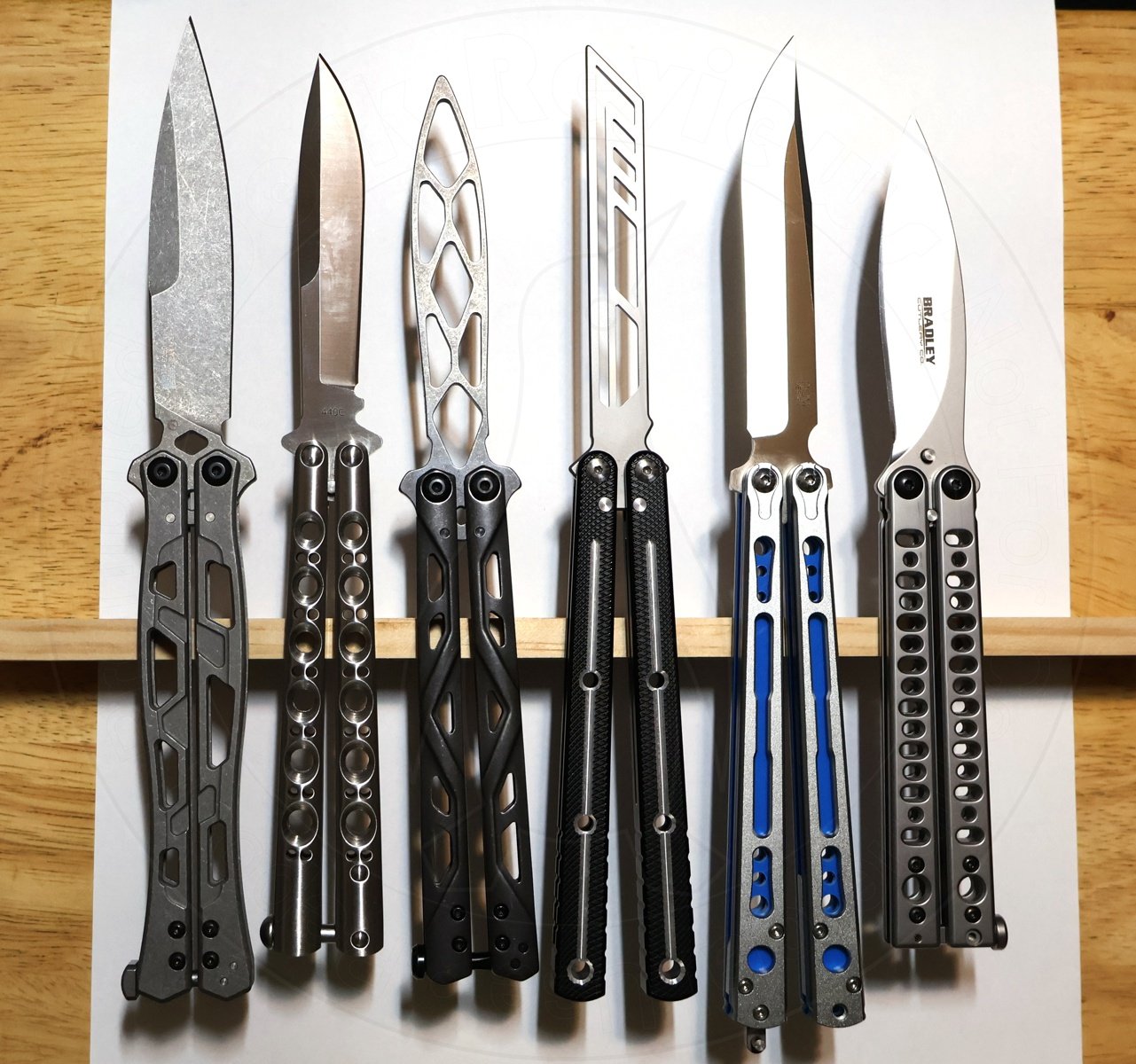
Here’s a smattering of knives I’ve got lying around my desk. Yes, I am showing off. Quiet from the peanut gallery.
They’re all balanced on their centers of gravity on a scrap of wood which is about 3/8" of an inch thick and an maybe 1-1/4" tall (note the shadow). It doesn’t take much of a push to tip any of them one way or other, or just a small shake to make the entire ensemble fall over.
I am ashamed to report that this getup doesn’t fit in my photo box, so this is taken on a trestle table lined up under my desk lamp in front of my keyboard. If this isn’t pure journalism, I don’t know just what the fuck is.
Amway, from left to right here is the Kershaw Moonsault, Benchmade Model 42, the Balanza, our Krake Raken clone from the other week, a HOM Chimera (with the latch retracted just because), and a Bradley Kimura. I’d say that’s a pretty decent spectrum of both new and oldschool. The Kimura and Moonsault are steelies, just like the Balanza. The Raken and Chimera are aluminum, and the '42 is titanium; all different weights and densities.
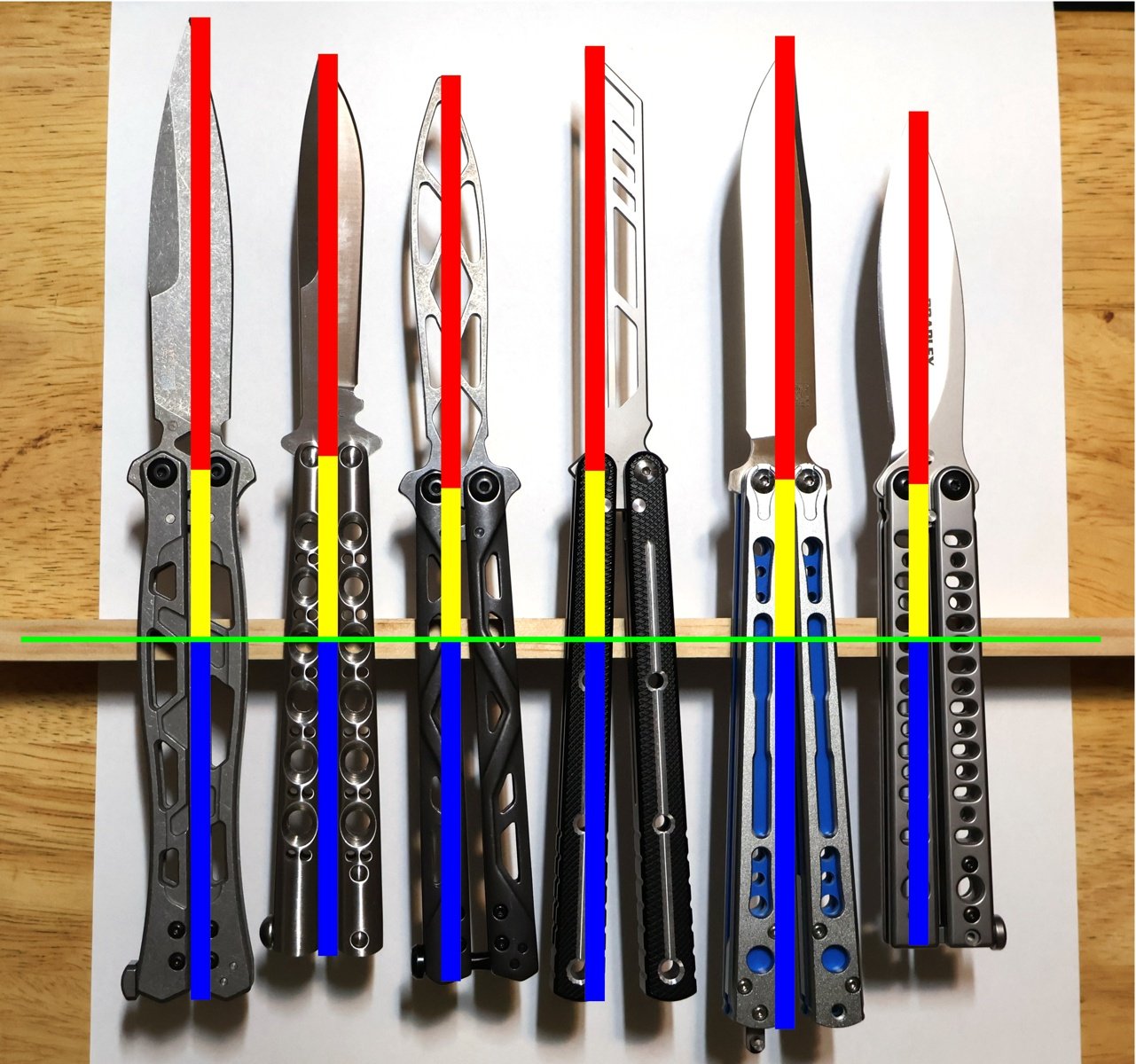
Did you know that you can use a $549 professional graphics editing package as a screen ruler? I mean, while we’re talking about value for your dollar and everything.
This allowed me to judge with ludicrous precision the proportionate distance from the tip (red) and tail (blue) to the point of balance (green), as well as the offset from the center of the pivots to the balance point (yellow). Note especially the similarity between all those yellow bars.
Here are the results, in my very first Lemmy markdown table ever. Will it render correctly on your app or device? Add a new layer of excitement to your day; spin the wheel and we’ll find out:
| Knife | Foward of Balance | Rear of Balance | Offset from Pivot |
|---|---|---|---|
| Moonsault | 63.3% | 36.7% | 17.3% |
| Model 42 | 64.9% | 35.1% | 20.3% |
| Balanza | 62.3% | 37.7% | 16.7% |
| Krake Raken | 62.1% | 37.9% | 17.7% |
| Chimera | 60.8% | 39.2% | 16.1% |
| Kimura II | 63.3% | 36.7% | 18.6% |
What did we learn, kids?
- Competently designed balisongs have similar ratios of blade to handle mass, to the surprise only of keyboard warriors.
- The Balanza is marginally better balanced than a Model 42, so stick that in your pipe and smoke it.
- It’s also 0.2% less handle biased than the “mathematically tuned” Krake Raken. (Or maybe the Chinese copied mine inaccurately. Who knows.)
- Overall length of a knife has a lot more to do with how far in total distance the point of balance is from the pivots than much of anything else, including what its handles are made out of.
…So pick the knife with the length and total weight you’re comfortable with, and don’t worry so much, sport.
In real space, the point of balance of the Balanza is 1.588" from the center of the pivots, by my calipers. That’s a negligible difference to the Krake, which is 1.518", and I find it is perfectly to my liking. Maybe that’s because my actual carry knives are not neon colored and helium-filled fidget spinners with blades, but rather by preference my heavy and dependable BM51 clone or big steel linered Böker, or the Kimura. My other favorites are the dinky and short TGZUO titanium box cutter, or one of my Rockhoppers, or a Benchmade 32 Mini Morpho. All of which are either so damn tiny or strange – or both – they have no real analogue anyway, so they’re all their own thing. Trying to use any full sized trainer as a stand-in for those is probably a fool’s errand, so I don’t even try.
One point to mention is that the Krake Raken’s handles are overall longer than the Balanza’s despite the proportion of mass being about the same. So if you prefer a handle that’s just bigger, there you go.
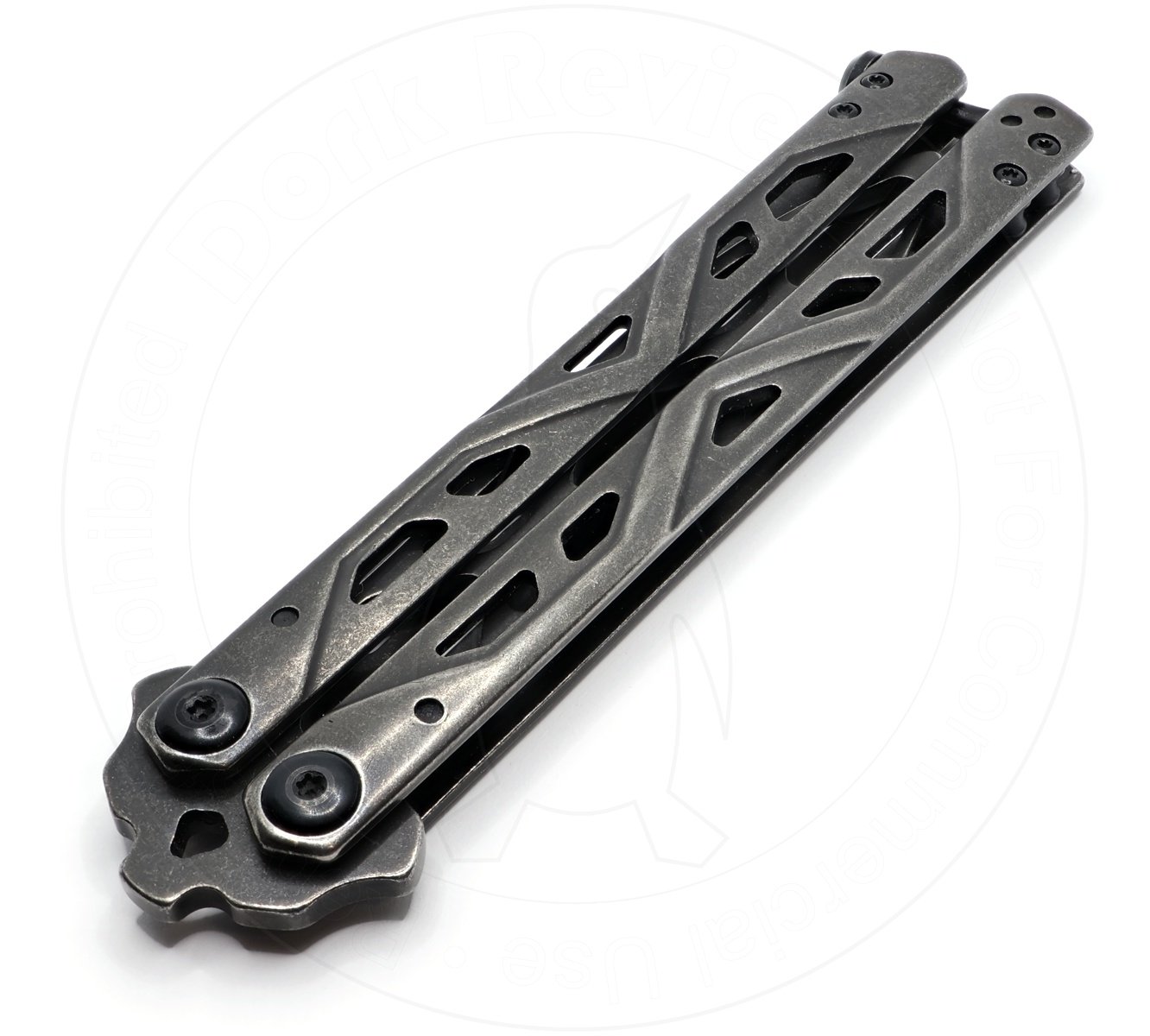
Anyway, you like what you like and more importantly you get used to what you get used to. If you give me a minute to acclimate I can do thumb rolls all day long with my plastic Rockhoppers, with or without a blade installed, despite the fact that they weigh so little that if a stiff breeze comes by you’ll never see yours again. And quite notwithstanding the insistence of any internet balisong bro that this is clearly impossible. (Proof. Suck it, physics. Slow-mo here.)
All this to say that the Balanza probably isn’t everyone’s cup of tea, and that’s okay. It’s got me written all over it, but your own mileage may vary. Maybe you really wish your knife’s point of balance were right on the pivots. Maybe you want it to only weigh a quarter of an ounce. Don’t let me tell you what to do.
(And of course, if you’re only ever going to use your balisong as a working knife for some reason and never learn or attempt anything more complicated to open it than a double-windmill, you’ll probably never even need a trainer knife at all, in which case the whole thing’s moot. You’ve already let me waste your time over it anyway, though, and now it’s too late.)
There are things the Balanza hasn’t got but it’d be bomber if it did. I guess the only thing I really miss is not having a spring loaded latch. That’d require a rethink of the spacers to make happen, for sure, but there’s plenty of room in there so they could have done it if they felt like it.
Oh, and you know. Maybe an edge.
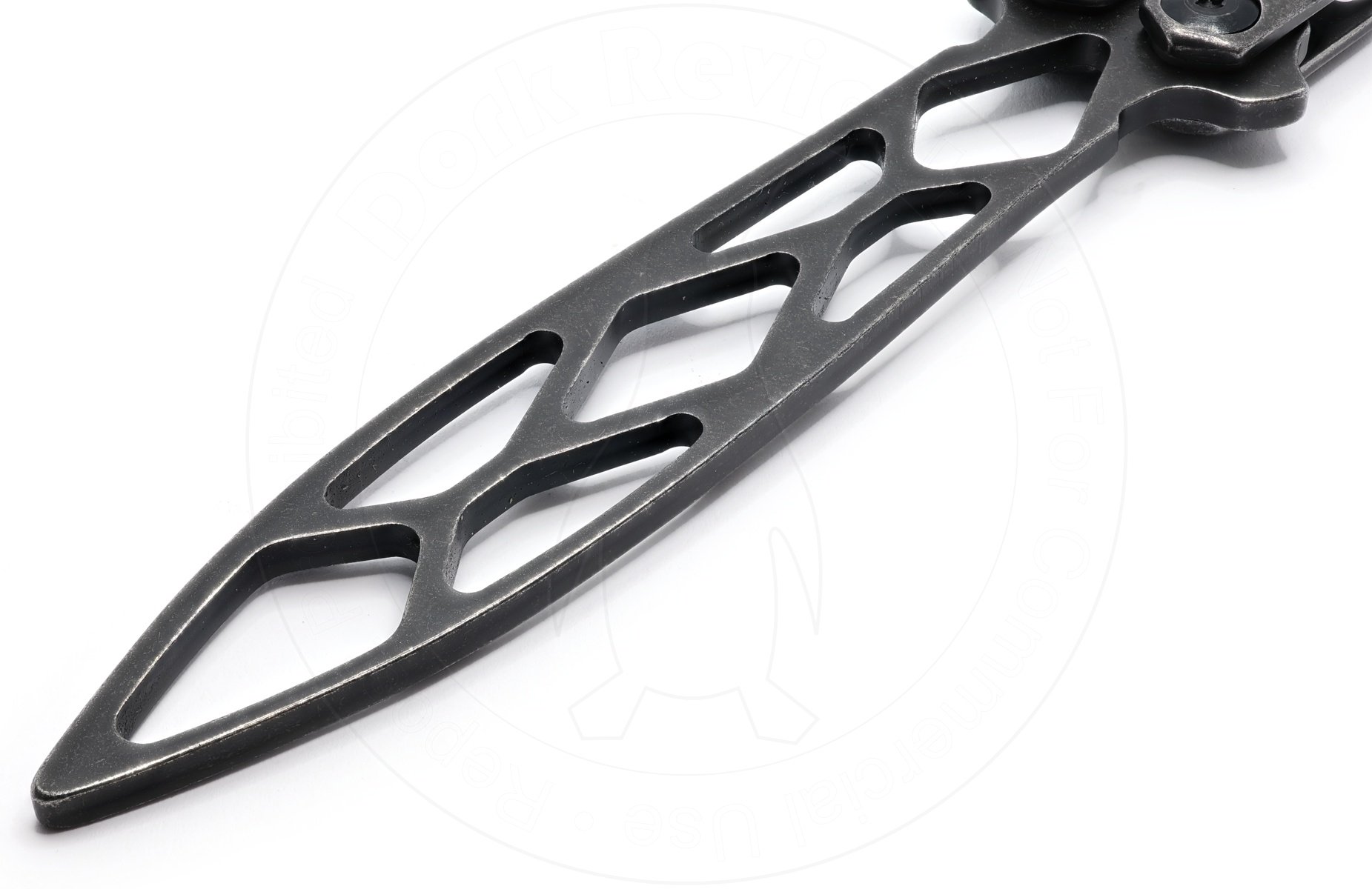
It’s got one other major thing going for it as well: It’s actually pretty quiet. Certainly not silent by any stretch of the imagination, but the racket it makes at the very least manages to be pleasant. This is again quite unlike its sibling Moonsault, which is a dissonant nightmare of weird resonances, clangs, bongs, and vibrations. The Balanza exhibits none of this, and it’s anyone’s guess as to why since superficially it’s constructed the exact same way. I don’t know if it’s just a fortunate coincidence that the Balanza is so much acoustically better or a terrible fluke that the much more expensive Moonsault is worse.
There is some jingle from the latch, which is not especially well fitted to its pin. But for the rest, just a single metallic click from each contact with a Zen pin, and nothing more. (Side note: Doing finger rolls is deceptively difficult while you’re wearing rubber gloves. But not nearly so much as using the slippery silk liners I usually wear whenever I need to show my hands in frame, speaking of craters.)
If you slap the side of the Balanza while it’s latched shut it does produce a tuning fork note. But it’s short and subdued, lower pitched, and not nearly as long nor as harsh as the nails-on-blackboard buzz the Moonsault makes if you do the same thing.
Forging Ahead
If you want a decent budget trainer for your money, buy this instead of some random faceless clone.
There, the gauntlet is thrown.
Don’t get me wrong, I like a good random faceless clone. I like them even better when they show up and they’re not crap, but part of this is because I’m weird and I love the thrill of the chase even more, where you never quite know in advance what you’re going to get. Normal people probably don’t.
The Balanza is a known quantity from a known manufacturer. Like, with an actual warranty and stuff. Kershaw backs this with their same lifetime warranty as everything else they make, and my singular past experience with Kershaw’s warranty is that if you ask them for one replacement screw they’ll send you about 60% of the components to build yourself an entire new knife, ship of Theseus style. That’s what happened to me when I needed a clip screw for a Brawler back in the day. I still have the extra entire clip, washers, pivots, and extra screws somewhere.
Consider the Balanza if you aren’t an aspiring TikTok star, or you don’t care what punters on the internet think. Buy it to practice. Buy it to use.
Just don’t buy any of Kershaw’s other balisongs, because they’re five times the price of this and somehow they’re worse.
There really needs to be a live blade version of this and I can’t fathom why there isn’t. That’d be clutch, and I’d happily buy one on the spot. Even in a cheap budget steel like 8Cr or D2.
…Maybe the Chinese will knock one off for us.
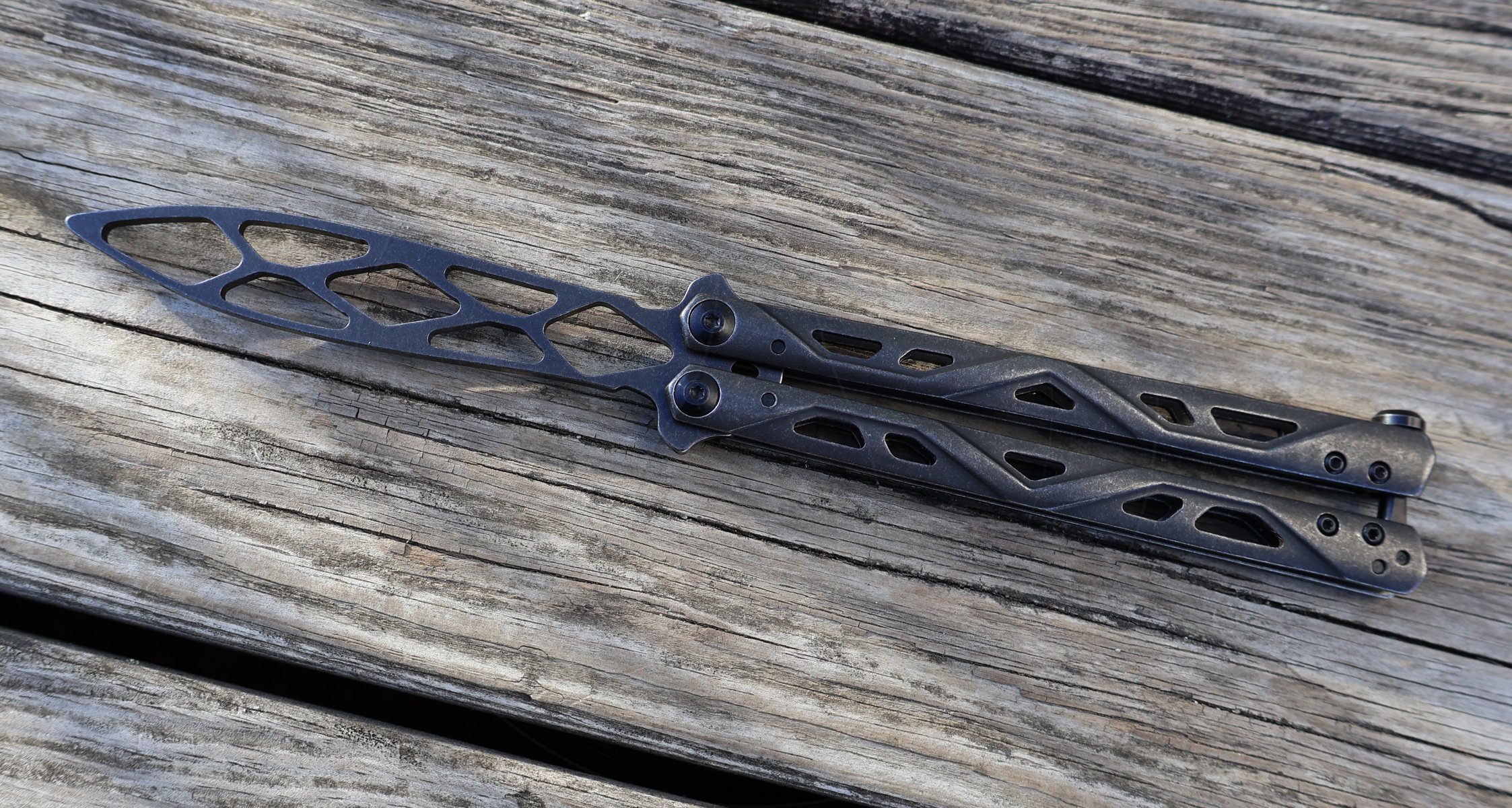
Love these posts, thanks for all the effort you put into them.
You know the drill.
I’ve even got stickers now. They’re exceptionally silly.
I’m still getting used to using my swanky new camera for these, and the exceptional detail I can create with it shows off not only the texture of my cheap background paper but also all the gunk and grunge stuck to my knives. So, sorry about that. There are a few whoppers visible on two of these photos that I didn’t notice until postprocessing, but at this rate I’m too lazy to reshoot them so just consider it like a scruffy game of Where’s Waldo.
The whole time “The Choice Is Yours” is running through my head. I am a product of the my youth for sure.
Nice video but could you find a neutral background next time? Kinda hard to see the knife on this tiny screen here
I’ll definitely take it under advisement. I have a limited selection of places in my house where the lighting is not crap, and conversely are not covered in computers or tools. So far, it’s been the penguins. I’m sure I can come up with something if I think about it hard enough.
I think I might try using my GoPro for video next time as well, since I can get a better frame rate with it while retaining a wide angle field of view. I think a large part of our problem here is that I’m locked to 30 FPS with what I’ve got above, which is motion blur city. Pair that with a grey knife and, well, here we are.
And unfortunately my available selection of lenses for the DSLR plus its video sensor crop make the field of view way too narrow for close up work like this.
Thanks pal



